The Constitution of 1776 provided for a Supreme Court of Appeals but did not specify its structure, leaving the General Assembly to organize the court by statute. [27] The first such statute was enacted at the October 1778 legislative session. From that time until 1788, no one was appointed or elected specifically to serve on the Supreme Court of Appeals. Rather, the court was made up of the three judges of the High Court of Chancery, the five judges of the General Court, and the three judges of the Court of Admiralty, each of whom was elected by the General Assembly to life terms on those courts and served on the Supreme Court of Appeals ex officio. [28]
The following judges were members of the court by virtue of having been elected judges of the High Court of Chancery, the General Court, and the Court of Admiralty, in the courts' order of precedence under the statute. [28] The terms listed below run from each member's accession to those respective courts, which were created in 1776 and 1777, before the Supreme Court of Appeals was created. Ex officio membership ended on December 24, 1788, when the Supreme Court of Appeals became a separate body with five judges. [29]
The High Court of Chancery: [30]
- Edmund Pendleton, January 14, 1778 – December 24, 1788 [31]
- George Wythe, January 14, 1778 – December 24, 1788 [31]
- Robert Carter Nicholas Sr., January 14, 1778 – November 1780 [31]
- John Blair Jr., November 23, 1780 – December 24, 1788 [31]
The General Court: [32]
- Paul Carrington, January 23, 1778 – December 24, 1788 [31]
- Thomas Mason, January 23, 1778 – May 28, 1778 [31]
- Joseph Jones, January 23, 1778 – October 1779 [31]
- John Blair Jr., January 23, 1778 – November 23, 1780 [31]
- John Tazewell, May 29, 1778 – November 1781 [31]
- Bartholomew Dandridge, May 29, 1778 – April 1785 [31]
- Peter Lyons, October 20, 1779 – December 24, 1788 [31]
- William Fleming, November 25, 1780 – December 24, 1788 [31]
- James Mercer, November 30, 1781 – December 24, 1788 [31]
- Henry Tazewell, April 25, 1785 – December 24, 1788 [31]
- Edmund Winston, December 11, 1788 – December 24, 1788 [31]
The Court of Admiralty: [33]
- Richard Carey, December 17, 1776 – December 24, 1788 [31]
- Benjamin Holt, December 17, 1776 – unknown [31]
- Bernard Moore, December 17, 1776 – unknown [31]
- Benjamin Waller, May 1779 – December 1785 [31]
- William Roscoe Wilson Curl, May 1779 – unknown [31]
- James Henry, unknown – December 24, 1788 [31]
- John Tyler, December 20, 1785 – December 24, 1788 [31]
Members since 1788
In December 1788, within the broad authority provided by the Constitution of 1776, the General Assembly re-organized the Supreme Court of Appeals as a separate court with five judges elected by the legislature to life terms. [29] The General Assembly elected two incumbent judges of the High Court of Chancery and three incumbent judges of the General Court as the first judges of the Supreme Court of Appeals in their own right. [31] While the court has remained separate ever since, the number of seats has varied. In January 1807, while one of the five seats was vacant, the General Assembly reduced the number to four with the provision that it be further reduced to three upon the next vacancy. [34] The number was restored to five in January 1811. [35]
The next significant alteration to the court came with the Constitution of 1851. It provided for the popular election of judges to the court, one from each of five districts, and imposed a twelve-year term. [36] As the Emancipation Proclamation became effective in Virginia during the American Civil War (particularly after the Commonwealth surrendered in April 1865 and 13th Amendment became effective in December 1865), the 1851 Constitution's authorization of slavery became illegal under federal law. Thus, Virginia needed a new Constitution.
Federal authorities in occupied areas called a convention with delegates from occupied areas only, which proclaimed the Constitution of 1864. Although voters statewide never were asked to authorize it in a referendum, it came into (disputed) effect, until a new state Constitution was adopted by popular referendum, then undisputedly came into effect in 1870. Federal military authorities allowed voters statewide to elect delegates to the Virginia Constitutional Convention of 1868. Virginia voters overwhelmingly ratified that document the following year, except for certain provisions penalizing former Confederates, which failed. The Constitution of 1864 had ended popular election of judges, instead providing (for the first time) that the General Assembly would elect the judges from candidates nominated by the Governor. [37] It also reduced the court to three judges. [38] On June 3, 1869, during Congressional Reconstruction, Major General John Schofield (who governed Virginia as Military District No. 1 and also led efforts to allow separate votes on the proposed Constitution and anti-Confederate provisions), dismissed all three elected judges because a new federal law required removal of officials in Texas and Virginia with any record of service to the Confederacy. On June 9, Schofield appointed three Union sympathizers (whom he had previously appointed judges of lower courts, where they had performed satisfactorily) as their replacements. Those three judges served (and issued binding rulings) until the new state Constitution came into effect and legislators elected replacements. [39]
The post-Reconstruction Constitution of 1870 eliminated the short-lived provision for gubernatorial nominations, as well as restored the court to five judges. [40] None of the three Union men was elected to the Court by the General Assembly. Legislators did elect two of the three judges elected by voters, and three additional judges. Legislation also allowed the court's members to elect their President, and in March 1870, the new Court elected R.C.L. Moncure (who had the most seniority) their President (the third man to hold that title). [39]
The Constitution of 1902 staggered the five seats by requiring that at the next election of judges, one judge would be elected to a term of 4 years, one to a term of 6 years, one to a term of 8 years, one to a term of 10 years, and one to a term of 12 years. [41] It perpetuated this staggering by providing that any new judge elected to fill a vacancy would serve only the unexpired portion of his predecessor's term. [42]
In 1906, the General Assembly re-elected each of the five incumbent judges, whose terms were all due to expire the following January 1, to fill the newly staggered seats. An amendment ratified in 1928 increased the number of seats to seven but it did not stagger the two new seats. The Constitution of 1971 eliminated the staggering of seats by providing that any new judge elected to fill a vacancy serve a full twelve-year term. [4]
These are the former members of the court from 1788, in order of their accession to office. Those who served as presiding officer are designated by italics.
- Edmund Pendleton , December 24, 1788 [31] – October 23, 1803 [43]
- John Blair Jr., December 24, 1788 [31] – September 30, 1789 [31]
- Paul Carrington, December 24, 1788 [31] – January 1, 1807 [31]
- Peter Lyons , December 24, 1788 [31] – July 30, 1809 [31]
- William Fleming , December 24, 1788 [31] – February 15, 1824 [44]
- James Mercer, November 14, 1789 [31] – October 1793 [31]
- Henry Tazewell, November 6, 1793 [31] – November 1794 [31]
- Spencer Roane, April 13, 1795 [45] – September 4, 1822 [46]
- St. George Tucker, April 11, 1804 [45] – April 2, 1811 [45]
- James Pleasants, January 30, 1811 [31] – March 1811 [31]
- Francis T. Brooke , March 4, 1811 [45] – March 3, 1851 [47]
- William H. Cabell , April 3, 1811 [45] – 1852 [48]
- John Coalter, June 1, 1811 [45] – March 23, 1831 [49]
- John W. Green, October 11, 1822 [46] – February 5, 1834 [50]
- Dabney Carr, February 24, 1824 [44] – January 8, 1837 [51]
- Henry St. George Tucker Sr. , March 1831 [52] – 1841 [53]
- William Brockenbrough, February 20, 1834 [50] – December 10, 1838 [54]
- Richard E. Parker, February 9, 1837 [51] – September 10, 1840 [55]
- Robert Stanard, January 19, 1839 [56] – May 14, 1846 [57]
- John J. Allen , December 14, 1840 [55] – 1866 [58]
- Briscoe Baldwin, January 29, 1842 [53] – 1852 [48]
- William Daniel, December 15, 1846 [57] – 1866 [58]
- Richard C. L. Moncure , March 13, 1851 [47] – June 3, 1869, [59] 1870 – August 24, 1882 [60]
- Green Berry Samuels, 1852 [48] – January 5, 1859 [61]
- George Hay Lee, 1852 [48] – 1866 [58]
- William J. Robertson, May 1859 [62] – 1866 [58]
- Lucas P. Thompson, 1866 (elected but died prior to taking office) [58]
- William T. Joynes, 1866 [58] – June 3, 1869, [59] 1870 – March 2, 1872 [63]
- Alexander Rives, 1866 [58] – June 3, 1869 [59] [64]
- Horace Blois Burnham (June 9, 1869 – February 22, 1870) [59]
- Orloff M. Dorman (June 9, 1869 – March 1, 1870) [59]
- Westel Willoughby (June 9, 1869 – March 1, 1870) [59]
- Joseph Christian January 1, 1871 [64] – 1883 [65]
- Waller Redd Staples, January 1, 1871 [64] – January 1, 1883 [65]
- Francis T. Anderson, January 1, 1871 [64] – January 1, 1883 [65]
- Wood Bouldin, April 10, 1872 [66] – October 10, 1876 [67]
- Edward C. Burks, November 1876 [68] – January 1, 1883 [65]
- Lunsford L. Lewis , August 28, 1882 [60] – January 1, 1895 [69]
- Robert A. Richardson, January 1, 1883 [65] – January 1, 1895 [69]
- Thomas T. Fauntleroy, January 1, 1883 [65] – January 1, 1895 [69]
- Drury A. Hinton, January 1, 1883 [65] – January 1, 1895 [69]
- Benjamin W. Lacy, January 1, 1883 [65] – January 1, 1895 [69]
- John W. Riely, January 1, 1895 [70] – August 20, 1900 [71]
- John Alexander Buchanan, January 1, 1895 [70] – January 12, 1916 [72]
- James Keith , January 1, 1895 [70] – June 10, 1916 [73]
- Richard H. Cardwell , January 1, 1895 [70] – November 16, 1916 [74]
- George Moffett Harrison , January 1, 1895 [70] – March 6, 1917 [74]
- Archer Allen Phlegar, October 1, 1900 [71] – February 1901 [75]
- Stafford G. Whittle , March 1901 [75] – December 31, 1919 [76]
- Joseph L. Kelly , January 12, 1916 [72] – January 31, 1924; [77] March 10, 1925 [78] – April 14, 1925 [78]
- Robert R. Prentis , December 16, 1916 [74] – November 25, 1931 [79]
- Frederick W. Sims , February 8, 1917 [73] – June 12, 1925 [78]
- Martin P. Burks, March 22, 1917 [74] – April 30, 1928 [80]
- Edward W. Saunders, March 9, 1920 [76] – December 16, 1921 [81]
- Jesse F. West, February 1, 1922 [81] – October 25, 1929 [82]
- Preston W. Campbell , January 31, 1924 [77] – October 1, 1946 [83]
- Richard Henry Lee Chichester , June 1, 1925 [84] – February 3, 1930 [82]
- Henry W. Holt , June 1, 1928 [80] – October 4, 1947 [85]
- Louis S. Epes, November 20, 1929 [82] – February 14, 1935 [86]
- Herbert B. Gregory, February 1, 1930 [87] – March 9, 1951 [88]
- Edward W. Hudgins , February 1, 1930 [87] – July 29, 1958 [89]
- George L. Browning, February 19, 1930 [87] – August 16, 1947 [85]
- Joseph W. Chinn, December 3, 1931 [79] – August 16, 1936 [90]
- John W. Eggleston , February 26, 1935 [86] – October 1, 1969 [91]
- Claude V. Spratley, August 27, 1936 [90] – September 30, 1967 [92]
- Archibald C. Buchanan, October 1, 1946 [83] – October 1, 1969 [91]
- Abram Penn Staples, October 7, 1947 [85] – January 15, 1951 [88]
- Willis D. Miller, November 17, 1947 [85] – December 20, 1960 [93]
- Lemuel F. Smith, February 15, 1951 [88] – October 15, 1956 [94]
- Kennon C. Whittle, March 14, 1951 [88] – February 1, 1965 [95]
- Harold Fleming Snead , January 14, 1957 [94] – September 30, 1974 [96]
- Lawrence W. I'Anson , September 3, 1958 [89] – January 31, 1981 [97]
- Harry L. Carrico , January 30, 1961 [93] – January 31, 2003 [98]
- Thomas C. Gordon, February 17, 1965 [95] – May 31, 1972 [99]
- Albertis Harrison, October 23, 1967 [92] – December 31, 1981 [20]
- Alexander Harman, October 1, 1969 [91] – December 31, 1979 [100]
- George M. Cochran, October 1, 1969 [91] – April 20, 1987 [101]
- Richard Harding Poff, August 31, 1972 [99] – December 31, 1988 [102]
- Christian Compton, October 1, 1974 [96] – February 2, 2000 [103]
- William Carrington Thompson, February 19, 1980 [100] – March 2, 1983 [104]
- Roscoe B. Stephenson Jr., March 2, 1981 [97] – July 1, 1997 [105]
- John Charles Thomas, April 25, 1983 [104] – November 1, 1989 [102]
- Henry H. Whiting, April 30, 1987 [101] – August 12, 1995 [23]
- Elizabeth B. Lacy, January 4, 1989 [102] – August 16, 2007 [9]
- Leroy R. Hassell Sr. , December 28, 1989 [106] – February 9, 2011 [107]
- Barbara Milano Keenan, July 2, 1991 [21] – March 12, 2010 [108]
- Cynthia D. Kinser , July 8, 1997 [105] – December 31, 2014 [109]
- Donald W. Lemons , March 16, 2000 [103] – February 1, 2022 [110]
- G. Steven Agee, March 1, 2003 [98] – June 30, 2008 [25]
- William C. Mims, April 1, 2010 [108] – March 31, 2022 [111]
- Elizabeth A. McClanahan, August 1, 2011 [12] – September 1, 2019 [112]
- Jane Marum Roush, August 1, 2015 [113] – February 12, 2016 [114]
Succession of seats between 1895 and 2022
In 1895, for the first time, the General Assembly elected a full bench of five new judges. [115] Consequently, any line of succession between a specific justice of the current court and a judge elected before 1895 necessarily would be arbitrary. However, when the General Assembly re-elected the incumbent judges in 1906 to fill the staggered seats created by the Constitution of 1902, it elected a specific judge to each seat: it re-elected Judge Cardwell for 4 years, Judge Whittle for 6, Judge Buchanan for 8, Judge Keith for 10, and Judge Harrison for 12. [116] It therefore was possible to trace the line of succession of each of these seats, and the two new seats created in 1928, to its successive occupants.
| Seat 1 |
|---|
| Designated for a 4-year term in 1906 | | Member | Acceded | Vacated | | Richard H. Cardwell | Jan. 1, 1895 | Nov. 16, 1916 | | Robert R. Prentis | Dec. 16, 1916 | Nov. 25, 1931 | | Joseph W. Chinn | Dec. 3, 1931 | Aug. 16, 1936 | | Claude V. Spratley | Aug. 27, 1936 | Sept. 30, 1967 | | Albertis Harrison | Oct. 23, 1967 | Dec. 31, 1981 | | Charles S. Russell | Mar. 1, 1982 | July 1, 1991 | | Barbara Milano Keenan | July 2, 1991 | Mar. 12, 2010 | | William C. Mims | April 1, 2010 | Mar. 31, 2022 | | Thomas P. Mann [117] [118] [119] | Aug. 1, 2022 | |
| | Seat 2 |
|---|
| Designated for a 6-year term in 1906 | | Member | Acceded | Vacated | | John W. Riely | Jan. 1, 1895 | Aug. 20, 1900 | | Archer Allen Phlegar | Oct. 1, 1900 | Jan. 1901 | | Stafford G. Whittle | Mar. 1901 | Dec. 31, 1919 | | Edward W. Saunders | Mar. 9, 1920 | Dec. 16, 1921 | | Jesse F. West | Feb. 1, 1922 | Oct. 25, 1929 | | Louis S. Epes | Nov. 20, 1929 | Feb. 14, 1935 | | John W. Eggleston | Feb. 26, 1935 | Oct. 1, 1969 | | George M. Cochran [120] | Oct. 1, 1969 | Apr. 20, 1987 | | Henry H. Whiting | Apr. 30, 1987 | Aug. 12, 1995 | | Lawrence L. Koontz Jr. | Aug. 16, 1995 | Feb. 1, 2011 | | Elizabeth A. McClanahan [121] | Aug. 1, 2011 | Sept. 1, 2019 | | Teresa M. Chafin [17] | Sept. 1, 2019 | |
| | Seat 3 |
|---|
| Designated for an 8-year term in 1906 | | Member | Acceded | Vacated | | John A. Buchanan | Jan. 1, 1895 | Jan. 12, 1915 | | Joseph L. Kelly | Jan. 12, 1915 | Jan. 31, 1924 | | Preston W. Campbell | Jan. 31, 1924 | Oct. 1, 1946 | | Archibald C. Buchanan | Oct. 1, 1946 | Oct. 1, 1969 | | Alexander Harman [120] | Oct. 1, 1969 | Dec. 31, 1979 | | William Carrington Thompson | Feb. 19, 1980 | Mar. 2, 1983 | | John Charles Thomas | Apr. 25, 1983 | Nov. 1, 1989 | | Leroy R. Hassell Sr. | Dec. 28, 1989 | Feb. 9, 2011 | | Cleo Powell [121] | Aug. 1, 2011 | |
|
| Seat 4 |
|---|
| Designated for a 10-year term in 1906 | | Member | Acceded | Vacated | | James Keith | Jan. 1, 1895 | June 10, 1916 | | Frederick W. Sims | June 12, 1916 | Feb. 8, 1925 | | Joseph L. Kelly | Mar. 10, 1925 | Apr. 14, 1925 | | Richard Henry Lee Chichester | June 1, 1925 | Feb. 3, 1930 | | George L. Browning | Feb. 19, 1930 | Aug. 26, 1947 | | Abram Penn Staples | Oct. 7, 1947 | Jan. 15, 1951 | | Lemuel F. Smith | Feb. 15, 1951 | Oct. 15, 1956 | | Harold Fleming Snead | Jan. 14, 1957 | Sept. 30, 1974 | | Christian Compton | Oct. 1, 1974 | Feb. 2, 2000 | | Donald W. Lemons | Mar. 16, 2000 | Feb. 1, 2022 | | Wesley G. Russell Jr. [117] [118] [119] | July 1, 2022 | |
| | Seat 5 |
|---|
| Designated for a 12-year term in 1906 | | Member | Acceded | Vacated | | George Moffett Harrison | Jan. 1, 1895 | Mar. 6, 1917 | | Martin P. Burks | Mar. 22, 1917 | Apr. 30, 1928 | | Henry W. Holt | June 1, 1928 | Oct. 4, 1947 | | Willis D. Miller | Nov. 17, 1947 | Dec. 20, 1960 | | Harry L. Carrico | Jan. 30, 1961 | Jan. 31, 2003 | | G. Steven Agee | Mar. 1, 2003 | June 30, 2008 | | LeRoy F. Millette Jr. | Aug. 19, 2008 | July 31, 2015 | | Jane Marum Roush | Aug. 1, 2015 | Feb. 12, 2016 | | Stephen R. McCullough | Mar. 3, 2016 | |
| | Seat 6 |
|---|
| Created June 19, 1928 | | Member | Acceded | Vacated | | Herbert B. Gregory | Feb. 1, 1930 | Mar. 9, 1951 | | Kennon C. Whittle | Mar. 14, 1951 | Feb. 1, 1965 | | Thomas C. Gordon | Feb. 17, 1965 | May 31, 1972 | | Richard Harding Poff | Aug. 31, 1972 | Dec. 31, 1988 | | Elizabeth B. Lacy | Jan. 4, 1989 | Aug. 16, 2007 | | S. Bernard Goodwyn | Oct. 10, 2007 | |
|
| Seat 7 |
|---|
| Created June 19, 1928 | | Member | Acceded | Vacated | | Edward W. Hudgins | Feb. 1, 1930 | July 29, 1958 | | Lawrence W. I'Anson | Sept. 3, 1958 | Jan. 31, 1981 | | Roscoe B. Stephenson Jr. | Mar. 2, 1981 | July 1, 1997 | | Cynthia D. Kinser | July 8, 1997 | Dec. 31, 2014 | | D. Arthur Kelsey | Feb. 1, 2015 | |
|

The Tennessee Supreme Court is the highest court in the state of Tennessee. The Supreme Court's three buildings are seated in Nashville, Knoxville, and Jackson, Tennessee. The Court is composed of five members: a chief justice, and four justices. As of September 1, 2023, the chief justice is Holly M. Kirby.

The Virginia State Capitol is the seat of state government of the Commonwealth of Virginia, located in Richmond, the state capital. It houses the oldest elected legislative body in North America, the Virginia General Assembly, first established as the House of Burgesses in 1619.

The Supreme Court of Florida is the highest court in the U.S. state of Florida. It consists of seven justices—one of whom serves as Chief Justice. Six members are chosen from six districts around the state to foster geographic diversity, and one is selected at large.

The Supreme Court of Virginia is the highest court in the Commonwealth of Virginia. It primarily hears direct appeals in civil cases from the trial-level city and county circuit courts, as well as the criminal law, family law and administrative law cases that are initially appealed to the Court of Appeals of Virginia. Established in 1779 as the Supreme Court of Appeals, the Supreme Court of Virginia is one of the oldest continuously active judicial bodies in the United States.
The Court of Appeals of Virginia, established January 1, 1985, is an intermediate appellate court of 17 judges that hears appeals from decisions of Virginia's circuit courts and the Virginia Workers' Compensation Commission. The Court sits in panels of at least three judges, and sometimes hears cases en banc. Appeals from the Court of Appeals go to the Supreme Court of Virginia.
The Supreme Court of Appeals of West Virginia is the state supreme court of the state of West Virginia, the highest of West Virginia's state courts. The court sits primarily at the West Virginia State Capitol in Charleston, although from 1873 to 1915, it was also required by state law to hold sessions in Charles Town in the state's Eastern Panhandle. The court also holds special sittings at various locations across the state.
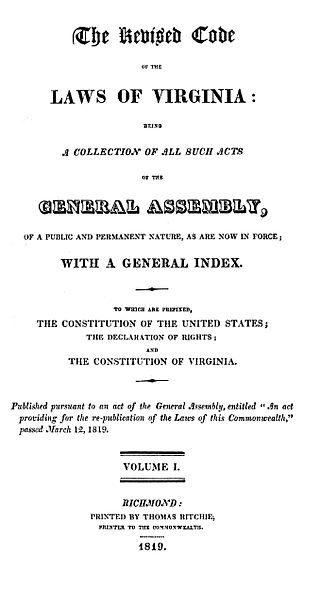
The Code of Virginia is the statutory law of the U.S. state of Virginia and consists of the codified legislation of the Virginia General Assembly. The 1950 Code of Virginia is the revision currently in force. The previous official versions were the Codes of 1819, 1849, 1887, and 1919, though other compilations had been printed privately as early as 1733, and other editions have been issued that were not designated full revisions of the code.
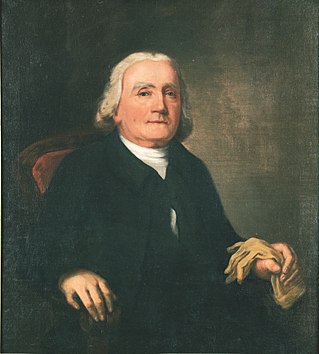
Peter Lyons was a Virginia lawyer and judge. He was elected as one of the first justices to serve on the Virginia Court of Appeals, and he later became the second President and chief justice of the Court.

Harry Lee Carrico was a member, Chief Justice, and Senior Justice of the Supreme Court of Virginia. His tenure as an active Justice of the Court, at more than 42 years, was the longest of any justice excluding William Fleming, who served nearly 44 years, from 1780 to 1824. Because current law requires active judges and Justices in Virginia to retire or take senior status on or shortly after their seventieth birthdays, Justice Carrico's longevity record likely will not be challenged.
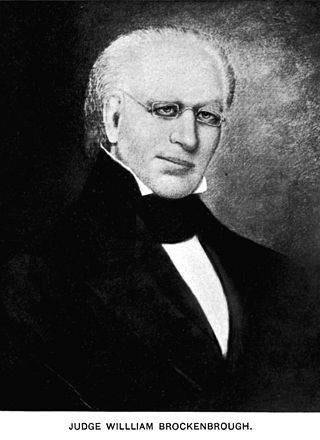
William Brockenbrough was a Virginia lawyer, planter, politician and judge, including on what became the Supreme Court of Virginia.
Cynthia Dinah Kinser is an American lawyer who served as the chief justice of the Supreme Court of Virginia. Kinser was elected by the Virginia General Assembly to her first 12-year term to the Virginia Supreme Court in 1998, after being appointed by Governor George Allen to fill a 1997 vacancy. Kinser was elected to a second 12-year term during the 2010 session of the General Assembly. She became Chief Justice of the Virginia Supreme Court on February 1, 2011. She is the first woman to hold the office of Chief Justice on the Court.
Samuel Bernard Goodwyn is the chief justice of the Supreme Court of Virginia. He previously served as a circuit court judge in Chesapeake.
The government of Virginia combines the executive, legislative and judicial branches of authority in the Commonwealth of Virginia. The current governor of Virginia is Glenn Youngkin. The State Capitol building in Richmond was designed by Thomas Jefferson, and the cornerstone was laid by Governor Patrick Henry in 1785. Virginia currently functions under the 1971 Constitution of Virginia. It is Virginia's seventh constitution. Under the Constitution, the government is composed of three branches: the legislative, the executive and the judicial.

John Tyler Sr. was an American lawyer, planter, politician and judge who served in the Virginia House of Delegates and became 15th Governor of Virginia and later United States district judge of the United States District Court for the District of Virginia. He was the father of U.S. President John Tyler.
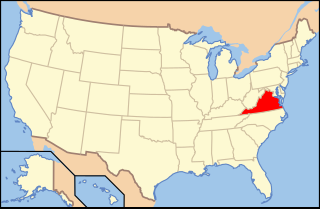
Lesbian, gay, bisexual, and transgender (LGBT) people in the Commonwealth of Virginia enjoy the same rights as non-LGBT people. LGBT rights in the state are a recent occurrence with most improvements in LGBT rights occurring in the 2000s and 2010s. Same-sex marriage has been legal in Virginia since October 6, 2014, when the U.S. Supreme Court refused to consider an appeal in the case of Bostic v. Rainey. Effective July 1, 2020, there is a state-wide law protecting LGBT persons from discrimination in employment, housing, public accommodations, and credit. The state's hate crime laws also now explicitly include both sexual orientation and gender identity.
The Judiciary of Virginia is defined under the Constitution and law of Virginia and is composed of the Supreme Court of Virginia and subordinate courts, including the Court of Appeals, the Circuit Courts, and the General District Courts. Its administration is headed by the Chief Justice of the Supreme Court, the Judicial Council, the Committee on District Courts, the Judicial Conferences, the Judicial Inquiry and Review Commission, and various other offices and officers.
The General Court was the first and highest court of colonial Virginia, and the highest criminal court in the Commonwealth of Virginia from 1814-1852.

The Supreme Court of the Republic of Texas was the court of last resort for legal matters in the Republic of Texas from the Republic's independence from Mexico in 1836 until its annexation by the United States of America in 1846. The current Supreme Court of Texas was established that year.
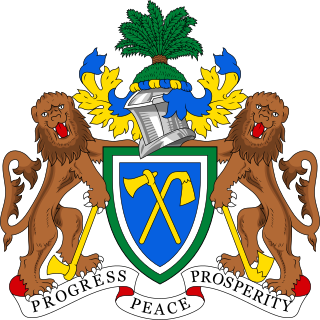
The Supreme Court of the Gambia is a superior court of record and the highest court in The Gambia. Established in 1851, it has appellate and original jurisdiction over any law exceeding the powers conferred by the Constitution or any law upon the National Assembly or any other person or authority.
Edmund Winston Sr. was a lawyer, politician, jurist, and patriot of the American Revolution for Virginia.











